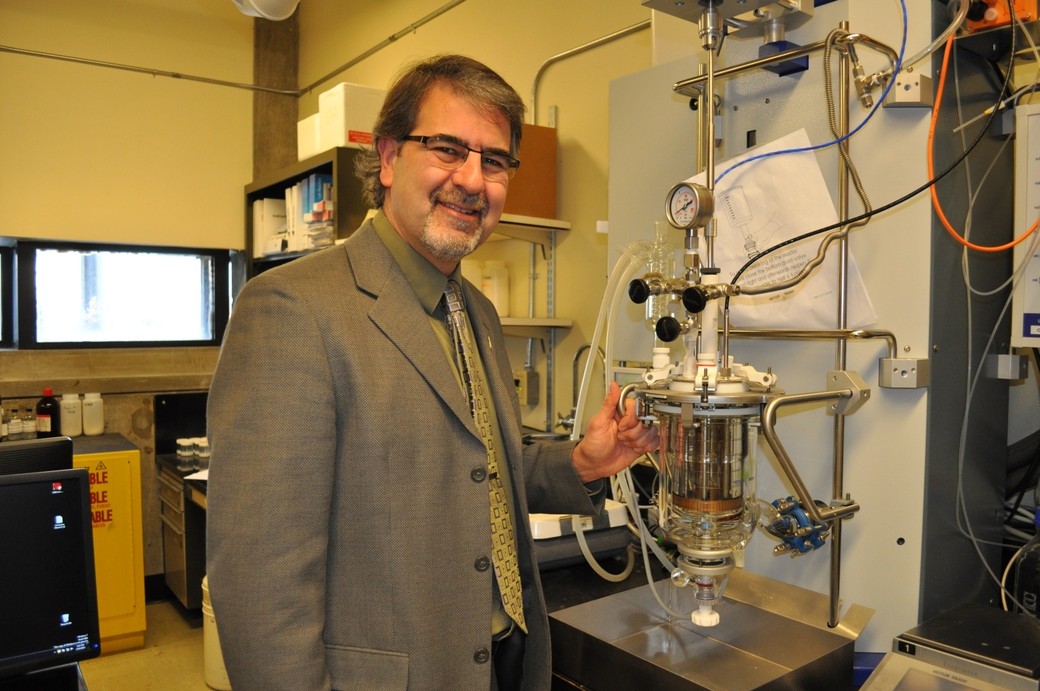
Let Me Give You One Word: Plastics
Ottawa scientist uses waste for greener polymers
Mr. McGuire: I just want to say one word to you. Just one word.
Benjamin: Yes, sir.
Mr. McGuire: Are you listening?
Benjamin: Yes, I am.
Mr. McGuire: Plastics.
Benjamin: Exactly how do you mean?
Little did Benjamin know what Mr. McGuire’s advice meant in The Graduate–a film by Mike Nicholas that captivated screens of American cinemas in 1967. Little could he imagine how true his prophesy would be. Five decades later, this word means no sunny future.
Once a man-wonder, today, petroleum-based plastics deplete natural resources while their waste damages the environment. Each year, 280 million tonnes of plastics are manufactured globally, according to the United Nations Environment Programme. Less than 10 per cent is recycled. As a result, plastics take 1,000 years to break down, pollute the planet, kill marine life and contribute to carbon-dioxide emissions.
Why do humans need so much of this material?
The answer is simple: to package and to carry their groceries, to paint their walls and to make their cars. Packaging accounts for the largest part of the synthetic pie–close to 40 per cent. Canadian shoppers use almost 15 billion plastic bags per year.
The good news is more researchers across the world are searching for an alternative to the petroleum-based material. While many researchers target renewable resources: plants, vegetables and grains, University of Ottawa Chemical Engineering Professor Marc Dubé and his team target an accumulating resource–waste.
Orange peels, used frying oils, wood waste or crops that came from contaminated lands. The key ingredients here are renewable monomers such as glycerol, limonene and other natural derivatives that replace petroleum-based monomers, explains Dubé as he tours his two-lab chemical engineering facility at the University of Ottawa. Both rooms are equipped with reactors, measuring devices, glassware–everything for Dubé’s mission to replace fossil fuel based material with a friendlier alternative.
It’s essential for the world, Dubé says, to understand despite green policies and people’s ambitions to install solar panels, drive electric or hydrogen powered cars, if the planet runs out of oil, there won’t be any suitable material to do any of that.
“Almost everything in the world these days is made of polymers. There are, of course, other materials like wood, glass and metals. But the walls are painted with polymers. Most of our clothing is synthetic polymers. Packaging of our food comes from polymers. Car and computer parts are made of polymers,” Dubé says. “If we run out of petroleum, we will be in big trouble not just because of its effect on transportation, but on the materials we need.”
Dubé introduces his research assistant Yujie Zhang, who has agreed to demonstrate how green polymers are prepared. Zhang and her colleague Shanshan Ren are working with limonene, an extract from orange peels that can be used to make tapes and adhesives.
Zhang opens the doors of green chemistry. She wears proper attire: protective glasses, a face mask, a white mantle and gloves. Soup de jour: greener glue. The recipe of sustainable glue is simple. There are three ingredients: limonene, synthetic monomer and a catalyst.
The researcher mixes limonene and another monomer in a glass ampoule, adding a catalyst. Zhang stirs the mixture. Other stages follow: freezing in nitrogen, vacuuming out the air, heating in a water bath and waiting for about an hour until the liquid forms into a viscous material.
The work is tedious. Sometimes researchers spend more than twelve hours in the lab working with various chemicals. This is the reason Zhang has joined Dubé’s team. Unlike other research opportunities, research in sustainable polymers sounded less hazardous. Zhang says: “If I want to do research, I want to make sure: I will be healthy, and I am comfortable with my working environment.”
Above all, what drove Zhang in search of green material is a chance to do something good for people and the environment.
“If we use sustainable monomers – we have enormous resources, and for them we haven’t found a lot of applications. We can use these monomers to produce products – it will help the environment and make those products more environmentally friendly.”
Professor Dubé has a three-decade experience in chemical engineering. Aside from his work in sustainable polymer research, he worked with biofuels. In one of his experiments, Dubé converted waste cooking oil from restaurants into biodiesel.
Today, Dubé’s team works on other interesting projects. One of his PhD candidates, Samaneh Khanlari, looks into bioadhesives for surgery–ideal for out-of-clinic services during natural disasters. The bioplaster kills bacteria and heals wounds faster with no need for removal or follow-up.
Still, the research in green polymers is not overly prominent, says Professor of Chemical Engineering Alexander Penlidis from the University of Waterloo. Credible research and literature have started to appear only in the past two decades. Penlidis says, more scientists are doing research, and more industries are evaluating the potential. Professor Dubé’s research, however, stands out among other efforts in this area.

“Professor Dubé is in a unique position to evaluate the topic more systematically and holistically than other efforts, since he is looking at it not only from the polymer science and chemistry angle, but also from the property characterization and polymer engineering angle,” says Penlidis
There are many challenges facing society in order to embrace sustainable plastics, says Murray McLaughlin, executive director of Bioindustrial Innovation Canada (BIC). BIC, located in Sarnia, Ontario, serves as a bridge between biochemistry research and private market, with the mission to make sustainable innovation commercially available.
“There is a big interest among business community to use more sustainable polymers. Yet, compared to petroleum-based products, the price tag, quality and quantity available slows down the adoption of sustainable polymers in economies,” McLaughlin says.
McLaughlin says more research needs to be done. Accessibility to green products and technologies needs to be planned. Today, Canada’s economy doesn’t have the right infrastructure to switch to sustainable technologies.
“It’s also a lot of effort to move from existing products to different ones. Because you have to have large volumes of biomass supply consistently,” McLaughlin says. “You have to learn how to manage all that, as well as developing these new technologies.”
Downsized funding also hinders green and sustainable innovation. Economic downturn that started in 2008 has decreased research funding in clean technologies, says McLaughlin. Dubé thinks that the current government needs to do more to encourage the development of sustainable technologies.
Yet, despite the impediments, cogs of green engine are slowly aligning themselves to clean technologies. The engine grits, yet moves forward. More green technology companies and start-ups are entering the market. In the past eight years, McLaughlin says his company BIC has invested into 13 companies that operate in different aspects of sustainable technologies, generating more than 300 million of non-government investments in Ontario. Dubé also says that more industries show interest in working with him, to make their products greener.
Non-profits are also picking up pace. Sustainable Development Technology Canada (SDTC), a non-profit foundation, primarily funded by the government of Canada, provides funds to start-ups and projects that address climate change, air quality and clean water. In 2013, SDTC has provided early-stage support to 11 clean technology companies.
Back at the University of Ottawa, Dubé says, he is very “encouraged” by the fact more researchers are doing similar research–turning waste into polymers and diverting from the use of non-renewable resources. In fact, this May, the university will welcome a new professor who will be working with smart polymers that have special properties like responding to electrical signals. Dubé says: “This area of materials is exploding now.”
However, Dubé confesses he would rather not do this research. “It’s shameful” how much Canada consumes, he says.
Realizing people won’t be able to shut down oil rigs in the near future, Dubé and other researchers continue their quest for a greener, friendlier material. There is also a deep trust in good sense and the heart.
“I hope, we will reduce consumption, or at least use greener polymers,” Dubé says. “I think, people in Canada tend to have a good heart, they mean well. And, if they learn a new way doing things that causes less harm, they will do it.”
So, the engine of Canada’s big ship has started. The ship is set to sail to a greener future. It is the last call for missing passengers. Will you come on board?
Just say, “No, thanks” to a plastic bag next time you would be buying groceries.














